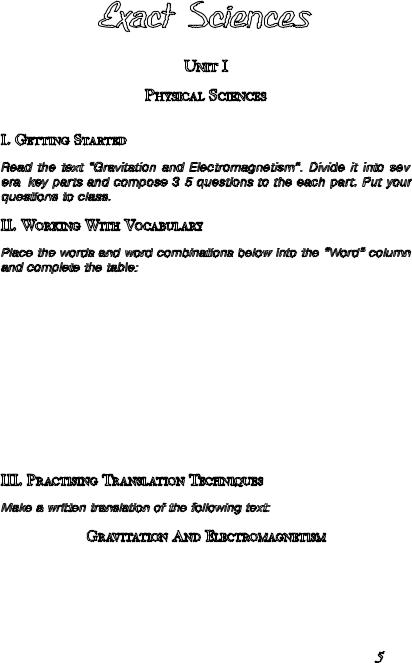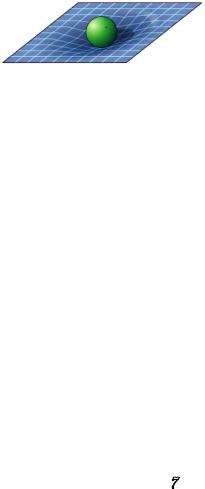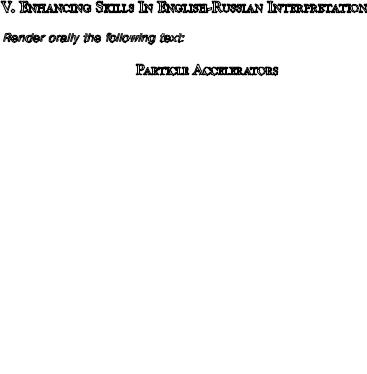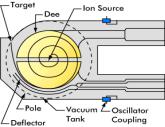
Учебник по НТП
.pdf
Предисловие
Данное учебное пособие предназначено для работы над различными видами технического перевода и практики преодоления переводческих трудностей. Оно состоит из четырех глав, каждая из которых содержит оригинальные, но значительно переработанные и сокращенные тексты и включает три тематических раздела
сдесятью заданиями:
1.Ознакомительное чтение текста, выделение его смысловых частей и составление плана-вопросника текста для общего понимания данной темы.
2.Составление глоссария по теме и его последующее обсуждение включают:
а) Тренировка навыков работы с печатными и электронными словарями;
б) Дефиниция термина на англ. языке; в) Построение деривативной модели термина;
г) Собственные примеры употребления данного термина или выражения;
д) Варианты переводов в зависимости от области применения термина (например, в математике, химии, метеорологии и т.п.).
3.Письменный перевод основного текста раздела с последующей проверкой и обсуждением в классе.
4.Упражнение на преодоление переводческих трудностей, которое также способствует расширению кругозора и углублению знаний в области науки и техники.
5.Практика устного перевода текста с английского на русский язык.
6.Практика устного перевода текста с русского на английский язык.
Тексты в упражнениях 5 и 6 тематически связаны и предоставляют обширный материал для составления студентами индивидуального
англо-русского и/или русско-английского глоссария по теме этих текстов с последующей “защитой” (т.е. почему данное слово важно
вконтексте темы) - объем 10-15 слов и выражений.
7.Преодоление лексических и грамматических переводческих трудностей.
8.Перевод английских предложений с грамматическими конструкциями, которые могут отсутсвовать в русском языке.
9.Перевод-эссе текста с поиском дополнительной информации по теме.
10.Повторение пройденного материала, закрепление лексики, составление понятийных тематических карт.
Удачной Вам работы и успехов в переводе!
Авторы

Exact Sciences
Unit I
Physical Sciences
I. Getting Started
Read the text “Gravitation and Electromagnetism“. Divide it into sev- eral key parts and compose 3-5 questions to the each part. Put your questions to class.
key parts and compose 3-5 questions to the each part. Put your questions to class.
II. Working With Vocabulary
Place the words and word combinations below into the “Word“ column and complete the table:
Word |
English |
Examples |
Russian |
|
definition |
of usage |
translation |
||
|
||||
|
|
|
|
|
|
|
|
|
the ultimate constituents, particle physicists, matter particles, quantitative theory of gravitation, gravity force, inverse (noun), gravitational constant, celestial mechanics, proportionality factor, inertial mass, to conjecture, accelerating frame, the Equivalence Principle, coordinate system, Einstein’s General Relativity, non-Euclidean Geometry, microcosm, four-dimensional space, geodesics, quantum theory, to quantise, Heisenberg’s Uncertainty Relation, momentum or energy.
III. Practising Translation Techniques
Make a written translation of the following text:
Gravitation And Electromagnetism
One of the basic features in physics is the occurrence of forces that keep matter together. From the physical point of view we try to systematise, that is to find out the ultimate constituents of matter and to define the forces that act between them. In the first case, we have been able to divide up matter into atoms and the atoms into nuclei and electrons, and then the nuclei into protons and neutrons. By colliding

protons with protons or protons with electrons, particle physicists have uncovered that all matter can be built from a number of quarks (a concept introduced by Murray Gell-Mann in the 60's) and leptons (electrons and neutrinos and their heavier cousins). In the same process physicists have uncovered basic forces that act between these matter particles, in particular, gravitation and electromagnetism.
The first quantitative theory of gravitation based on observations was formulated by Isaac Newton in 1687 in his Principia. He wrote about the gravity force that acts on the sun and the planets, and depends on the quantity of matter that they contain. It propagates to large distances and diminishes always as the inverse of the square of the distance. The formula for the force F between two objects with masses m1 and m2 a distance r away is thus:
F=Gm1m2/r2
where G is a constant of proportionality, called the gravitational constant. Newton’s theory was very successfully applied to celestial mechanics during the 18th and the beginning of the 19th century. For example J.C. Adams and U.J.J. Le Verrier were able to conjecture a planet outside of Uranus from irregularities in its orbit and, subsequently, Neptune was found.
Galilei was the first to observe that objects seemingly fall at the same speed regardless of their masses. In Newton’s equations the concept of mass occurs in two different equations. The second law says that a force F on a body with mass m gives an acceleration a according to the equation F=ma. In the law of gravity, the force of gravity F satisfies F=mg, where g depends on the other bodies exerting a force on the body (the earth usually, when we talk of the gravity force). In both equations m is a proportionality factor (the inertial mass and the gravitational mass) and there is no obvious reason that they should be the same for two different objects. However, all experiments indicate that they are. Einstein took this fact as the starting point for his theory of gravitation.
If you cannot distinguish the inertial mass from the gravitational one you cannot distinguish gravitation from an acceleration. When an astronaut in a rocket accelerates to get away from earth he feels a gravity force that is several times that on earth. Most of it comes from the ac-

celeration. If one cannot distinguish gravity from acceleration one can always substitute the gravity force by being in an accelerating frame. A frame in which the acceleration cancels the gravity force is called an inertial frame. Hence the moon orbiting the earth can instead be regarded to be in an accelerating frame. However this frame will be different from point to point since the gravity field changes. (In the example with the moon the gravity field changes direction from one point to another.) The principle that one can always find an inertial frame at every point of space and time in which physics follows the laws in the absence of gravitation is called the Equivalence Principle.
The fact that the gravitational force can be thought of as coordinate systems that differ from point to point means that gravity is a geometric theory. The true coordinate system that covers the whole of space and time is hence a more complex one than the ordinary flat ones we are used to from ordinary geometry.
This type of geometry is called Non-Euclidean Geometry. The force as we see it comes from properties of space and time. We say that spacetime is curved.
Consider a ball lying on a flat surface. It will not move, or if there is no friction, it could be in a uniform movement when no force is acting on it. If the surface is curved, the ball will accelerate and move down to the lowest point choosing the shortest path. Similarly, Einstein taught us that the four-dimensional space and time is curved and a body moving in this curved space moves along a geodesics which is the shortest path. Einstein showed that the gravity field is the geometric quantity that defines the so-called proper time, which is a concept that takes the same value in all coordinate systems similar to distance in ordinary space. He also managed to construct equations for the gravity field—the celebrated Einstein’s equations. Einstein’s theory of gravitation, or General Relativity, as he called it himself is one of the greatest triumphs of modern science.
It was James Clark Maxwell who, in 1865, finally unified the concepts of electricity and magnetism into one theory of electromagnetism. The theory is not totally symmetric in the electric and the magnetic fields though, since it only introduces direct sources to the electric field, the electric charges. A fully symmetric theory would also introduce magnetic charges predicted to exist by modern quantum theory but with such huge magnitudes that free magnetic charges must be extremely rare in our universe. For two static bodies with charges e1

and e2 the theory leads to Coulomb‘s Law giving the force between the two bodies where again k is a proportionality constant.
F=ke1e2/r2,
Note the resemblance with Newton‘s law for gravity. There is one difference though. While the gravitational force always is attractive, the electromagnetic one can also be repulsive. The charges can either have negative signs such as for the electron or be positive as for the proton. This leads to the fact that positive and negative charges tend to bind together such as in the atoms and hence, screen each other and reduce the electromagnetic field. Also in our bodies most charges are screened so there is a very minute electromagnetic force between a human being and the earth. The situation is very different for the gravity field. Since it is always attractive, every particle in the earth interacts with every particle in a human body, setting up a force with is just our weight.
The electromagnetic field can be understood as a stream of corpuscular bodies to be called photons (quanta of light) sent out from one particle to hit the other. The discovery that the electromagnetic field is quantised started the development of quantum mechanics and led us to a microcosm that is just built up by point-like objects and where forces occur when two particles hit each other. Quantum mechanics as such led to many new revolutionary concepts. One of the most important ones is Heisenberg’s Uncertainty Relation formulated by Werner Heisenberg in 1927, which states that one cannot measure position and momentum or energy and time exactly simultaneously.
One day Herr Doktor Heisenberg is pulled over for speeding. The policeman asks, «Do you know how fast you were going?» «No,» replies Heisenberg, «but I know exactly where I am!»
For a nucleus, one can either determine the position of an electron and know nothing of its momentum or know its momentum and nothing about its position. The full description of the electromagnetic force between elementary particles was formulated by Sin-Itiro Tomonaga, Richard Feynman and Julian Schwinger in independent works in the 1940’s. They formulated Quantum ElectroDynamics (QED). This is a theory that takes full account of quantum physics and special relativity, which is the underlying symmetry of the Maxwell’s Equations.

IV. Knowing Ins And Outs
Transliteration and transcription are some of the commonest translator’s tools. Transliteration is used to represent concepts or proper names in the corresponding characters of another alphabet. There exist many possible systems for transliterating, including GOST 1687671 (1983) from the Main Administration of Geodesy and Cartography of the former Soviet Union, and the United Nations standard (1987) based on GOST and used in the Russian Federation and increasingly in international cartographic products.
Transcription is the process of matching the sounds of one language to the script of another language. Standard transcription schemes include the International Phonetic Alphabet (IPA), and SAMPA, its ASCII equivalent.
In practice, there are also some mixed transliteration/transcription systems that transliterate a part of the original script and transcribe the rest. When using transliteration and transcription, mind that:
a)There used to be a tendency to adapt names of famous persons to the receiving language, i.e. in Italian—Carlo Dickens, Leone Tolstoi, Volfango Amedeo Mozart, etc. This practice is still being used, for example, in American English, where the Russian writer Tolstoy is known as "Leo", which is not the transliteration of the original name "Lev".
b)The spellings of names that have gained currency in other languages are generally retained. For example, the preferred English spelling for some Russian words are Czar, Moscow, Alexander, etc.
Write the following proper names in Russian using transcription and/or transliteration and/or adaptation:
Isaac Newton, Murray Gell-Mann, Galileo Galilei, John Couch Adams, Urbain Jean Joseph Le Verrier, Albert Einstein, James Clark Maxwell, Werner Karl Heisenberg, Sin-Itiro Tomonaga, Richard Phillips Feynman, Julian Schwinger, Ernest Rutherford, John Clive Ward, John Louis von Neumann, Emmy Noether, Charles-Augustin de Coulomb, Jules Henri Poincaré, Erwin Schrödinger, Leo Szilard, Niels Henrik David Bohr, Charles Babbage, Democritus of Abdera, Ada Byron Lovelace, Nicholas Copernicus, René Descartes, Wilhelm Conrad Röntgen, James Dewey Watson, Sir William Herschel, Antonie Van Leeuwenhoek, Alessandro Giuseppe Anastasio Volta.

V. Enhancing Skills In English-Russian Interpretation
Render orally the following text:
Particle Accelerators
To explore the smallest of the small, the objects as tiny as the atomic nucleus in studies of its structure and of the forces that hold it together, physicists use the largest of scientific instruments —particle accelerators, popularly called atom smashers. Accelerators are also needed to provide enough energy to create new particles, e.g. to recreate the conditions of the early universe. Generating minuscule fireballs of high density and high temperature, physicists produce the particles that were abundant a trillionth of a second after the Big Bang. Besides pure research, accelerators have practical applications in medicine and industry, most notably in the production of radioisotopes. A majority of the world’s particle accelerators are situated in the United States, either at major universities or national laboratories. In Europe the principal facility is at CERN near Geneva, Switzerland; in Russia important installations
exist at Dubna and Serpukhov.
Two atoms bump into each other: «I think I’ve lost an electron!», says one. «Are you sure?», replies the other. — «I’m positive!»
There are many types of accelerator designs, although all have certain features in common. Only charged particles (most commonly protons and electrons, and their antiparticles; less often deuterons, alpha particles, and heavy ions) can be artificially accelerated; therefore, the first stage of any accelerator is an ion source to produce the charged particles from a neutral gas. All accelerators use electric fields (steady, alternating, or induced) to speed up particles; most use magnetic fields to contain and focus the beam. Meson factories (the largest of which is at the Los Alamos, N.Mex., Scientific Laboratory), so called because of their copious pion production by high-current proton beams, operate at conventional energies but produce much more intense beams than previous accelerators; this makes it possible to repeat early experiments much more accurately. In linear accelerators the particle path is a straight line; in other machines, of which the cyclotron is the prototype, a magnetic field is used to bend the particles in a circular or spiral path. Linear Accelerators: The early linear accelerators used high voltage to produce high-energy particles; a large static electric charge was built
10

up, which produced an electric field along the length of an evacuated tube, and the particles acquired energy as they moved through the electric field. The Cockcroft-Walton accelerator produced high voltage by charging a bank of capacitors in parallel and then connecting them in series, thereby adding up their separate voltages. The Van de Graaff accelerator achieved high voltage by using a continuously recharged moving belt to deliver charge to a high-voltage terminal consisting of a hollow metal sphere. Today these two electrostatic machines are used in low-energy studies of nuclear structure and in the injection of particles into larger, more powerful machines. Linear accelerators can be used to produce higher energies, but this requires increasing their length.
Linear accelerators, in which there is very little radiation loss, are the most powerful and efficient electron accelerators; the largest of these, the Stanford University linear accelerator (SLAC), completed in 1957, is 2 mi (3.2 km) long and produces 20-GeV—in nuclear physics energies are commonly measured in millions (MeV) or billions (GeV) of electron-volts (eV)—electrons. New linear machines differ from earlier electrostatic machines in that they use electric fields alternating at radio frequencies to accelerate the particles, instead of using high voltage. The acceleration tube has segments that are charged alternately positive and negative. When a group of particles passes through the tube, it is repelled by the segment it has left and is attracted by the segment it is approaching. Thus the final energy is attained by a series of pushes and pulls. Recently, linear accelerators have been used to accelerate heavy ions such as carbon, neon, and nitrogen.
Circular Accelerators: In order to reach high energy without the prohibitively long paths required of linear accelerators, E. O. Lawrence proposed (1932) that particles could be accelerated to high energies in a small space by making them travel in a circular or nearly circular path.
In the cyclotron, which he invented, a cylindrical magnet bends the particle trajectories into a circular path whose radius depends on the mass of the particles, their velocity, and the strength of the magnetic field. The particles are accelerated within a hollow, circular, metal box that is split in half to form two sections, each in the shape of the capital letter D. A radio-frequency electric field is impressed across the gap between the D‘s so that every time a particle crosses the gap, the polarity of the D‘s is reversed and the particle gets an accelerating “kick.” The key to the simplicity of the cyclotron is that the period of revolution of a particle remains the same as the radius of the path increases because of the increase in velocity. Thus, the alternating electric field stays in step with the particles as they spiral outward from the center of the cyclotron to its circumference. However, according to the theory of relativity the mass of a particle increases as its velocity approaches the speed of light; hence, very energetic, high-velocity particles will have greater mass and thus
11

less acceleration, with the result that they will not remain in step with the field. For protons, the maximum energy attainable with an ordinary cyclotron is about 10 million electron-volts.
Two approaches exist for exceeding the relativistic limit for cyclotrons. In the synchrocyclotron, the frequency of the accelerating electric field steadily decreases to match the decreasing angular velocity of the protons. In the isochronous cyclotron, the magnet is
constructed so the magnetic field is stronger near the circumference than at the center, thus compensating for the mass increase and maintaining a constant frequency of revolution. The first synchrocyclotron, built at the Univ. of California at Berkeley in 1946, reached energies high enough to create pions, thus inaugurating the laboratory study of the meson family of elementary particles.
Further progress in physics required energies in the GeV range, which led to the development of the synchrotron. In this device, a ring of magnets surrounds a doughnut-shaped vacuum tank. The magnetic field rises in step with the proton velocities, thus keeping them moving in a circle of nearly constant radius, instead of the widening spiral of the cyclotron. The entire center section of the magnet is eliminated, making it possible to build rings with diameters measured in miles. Particles must be injected into a synchrotron from another accelerator. The first proton synchrotron was the cosmotron at Brookhaven (N.Y.) National Laboratory, which began operation in 1952 and eventually attained an energy of 3 GeV. The 6.2-GeV synchrotron (the bevatron) at the Lawrence Berkeley National Laboratory was used to discover the antiproton.
The 500-GeV synchrotron at the Fermi National Accelerator Laboratory at Batavia, Ill., was built to be the most powerful accelerator in the world in the early 1970s; the ring has a circumference of approximately 6 kilometers, or 4 miles. The machine was upgraded in 1983 to accelerate protons and counterpropagating antiprotons to such enormous speeds that the ensuing impacts deliver energies of up to 2 trillion electron-volts (TeV)—hence the ring has been dubbed the Tevatron. The Tevatron is an example of a so-called colliding-beams machine, which is really a double accelerator that causes two separate beams to collide, either head-on or at a grazing angle. Because of relativistic effects, producing the same reactions with a conventional accelerator would require a single beam hitting a stationary target with much more than twice the energy of either of the colliding beams.
12
